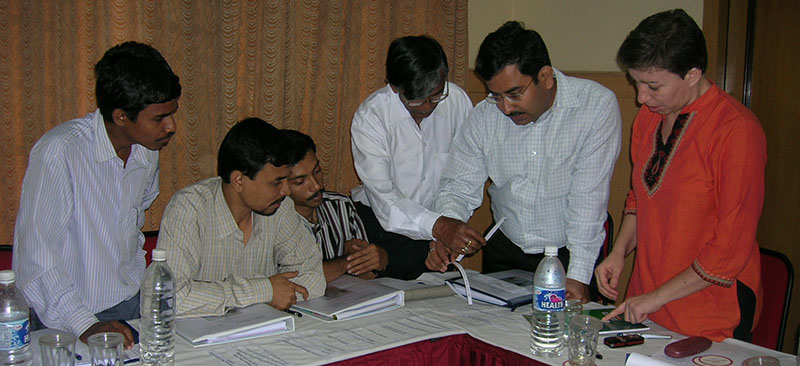Research team from MicroSave and ASKI conducted 24 FGDs with both urban and rural microfinance clients in the Philippines to measure the importance and relevance of client protection principles. Clients were also asked to rate ASKI on its adherence to each of the 7 CPPs. The key findings were- clients affirmed the importance of all seven CPPs. ‘Fair and Respectful Treatment of the Clients’ and ‘Appropriate Product Design and Delivery’ are the two most valued CPPs. ASKI was highly rated by clients on its adherence to CPPs with a high score of 2.91 on a 3.0 point rating scale.
Blog
Remittances through M-Banking Customer Perspectives: Observations from India
MicroSave studied major remittance corridors in India – Bihar/UP – Punjab, Orissa/Bihar – Gujrat, and found that multitude of players exist in the domestic market, though the banks are preferred channel. The presentation highlights findings from the study, including product features that will drive product use. Mr Manoj Sharma, Director, MicroSave, presented findings of the research at a workshop conducted by Axis Bank and Asian Development Bank in Mumbai.
Assessing Agent Profitability: MicroSave’s Agent Journal Studies
Profitability of the agents is at the foundation of a successful agent network. For the agent, the profitability not only determines her/his loyalty to the agent network manager (ANM), but also motivates her/him to provide better customer service, endeavour to increase the business and accept the inevitable challenges as the business proceeds. All these factors, in turn, drive the profitability of the ANM and the bank. Profitable agents also help in the recruitment of new agents by spreading a positive word of mouth about the business. In nutshell, the profitability is the major source of optimism about, and belief in, the business model. Hence, it is very important for all stakeholders to understand the drivers of agent profitability and try to make them work in the favour of the agents. However, developing a precise and realistic estimate of profitability necessarily requires understanding the drivers of profitability.
Profitability is an elusive target for most of the Business Correspondent agents. This is true for all the agents irrespective of the services offered by them. However, the remittance focussed agents are closest to the breakeven level, enabled by high transaction volumes. Transaction volume also explains why No Frills Account focussed agents, including the ones doing G2P payments, are typically so far away from breakeven. Such agents have too few transactions to result in a viable business case for the agents.
In case of remittance focussed agents, the small gap between current performance and a profitable performance can be filled in through specifically targeted measures to address issues such as technology downtime and marketing support. In case of NFA focussed agents, the key issue that needs to be addressed is the low volume of transactions. A key step towards doing this is improving the value proposition. This can be done by increasing the range of products to include a larger variety of banking products such as various categories of banking products, insurance and investment products. Value added services such as bill payments can also be added to the product bouquet.
Improving the Efficiency of Agent Networks
In this video Aleeda Fazal, Head of Mobile Commerce, Sicap, shares the inner workings of an agent network and talks about the different strategies that has been used to create world’s successful agent networks. She explains the challenges agents face in delivering the mobile banking services and what measures can be taken to improvise the agent network for effective delivery of the services. Going forwards she discusses the opportunities available for ATM deployment and mobile money in development markets.
Are Banks and Microfinance Institutions Natural Partners in Financial Inclusion?
This report presents the case of MFIs as one potentially viable channel with which banks can collaborate to reach the base of the pyramid market more economically. It also details the top strategic and operational choices that MFIs need to make before they function as a BC as well as the way forward.
What Are Clients Doing Post The AP MFI Crisis?
MicroSave conducted this study to examine the impact of the Andhra Pradesh crisis on borrowers, by collating client experiences, opinions and needs so as to help policy makers and key actors to devise solutions suited to client requirements. The study found that most clients have been forced to return to, or further expand their dependence on, moneylenders. The SHG-based system is too cumbersome and lends too little to sustain the businesses and other financial requirements of households used to accessing rapid and relatively large amounts of credit from MFIs in Andhra Pradesh.
In 59% sessions, respondents said that they have taken loans from moneylenders in the absence of loans from MFIs. The next most used source of credit for the respondents was the SHGs (37%) and “daily finance corporations” – another form of money lenders – (29%).
24% of respondents who had plans for business expansion have postponed them as access to credit had become difficult. Many (32%) respondents said that they had reduced the scale of their business because of lack of access to alternate sources of credit. In 12% of the sessions respondents said that they sold their assets such as house, vehicle, cattle, jewellery etc., to meet their productive (agriculture related expenses) as well as essential non-productive expenditure (school fees, marriage etc.).




